
Kuehneromyces mutabilis, commonly known as the sheathed woodtuft, is an edible mushroom that grows in clumps on tree stumps or other dead wood. A few other species have been described in the genus Kuehneromyces, but K. mutabilis is by far the most common and best known.

Discina gigas, commonly known as the snow mushroom, snowbank false morel, walnut, giants false morel, snow morel, snow false morel, calf brain, or bull nose, is a species of fungus and a member of the Ascomycota found in Europe. It is referred to as one of the false morels, due to its similar appearance and occurrence in the spring and early summer in similar habitats to true morels.

Panaeolus papilionaceus, also known as Agaricus calosus, Panaeolus campanulatus, Panaeolus retirugis, and Panaeolus sphinctrinus, and commonly known as Petticoat mottlegill, is a very common and widely distributed little brown mushroom that feeds on dung.
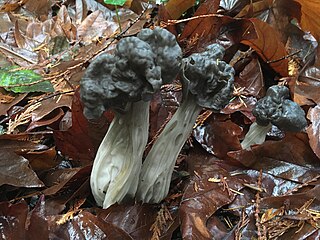
Helvella lacunosa, known as the slate grey saddle or fluted black elfin saddle in North America, simply as the elfin saddle in Britain, is an ascomycete fungus of the family Helvellaceae. It is one of the most common species in the genus Helvella. The mushroom is readily identified by its irregularly shaped grey cap, fluted stem, and fuzzy undersurfaces. It is usually found in Eastern North America and in Europe, near deciduous and coniferous trees in summer and autumn.

Stropharia aeruginosa, commonly known as the blue-green stropharia, or verdigris agaric, is a medium-sized green, slimy woodland mushroom, found on lawns, mulch and woodland from spring to autumn. The edibility of this mushroom is controversial - some sources claim that it is edible, while others claim it to be poisonous, although effects are little known and its toxic constituents undescribed.
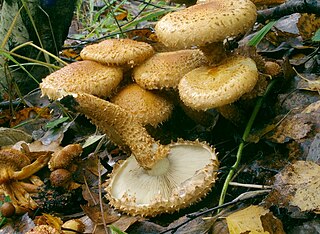
Pholiota is a genus of small to medium-sized, fleshy mushrooms in the family Strophariaceae. They are saprobes that typically live on wood. The genus has a widespread distribution, especially in temperate regions, and contains about 150 species.
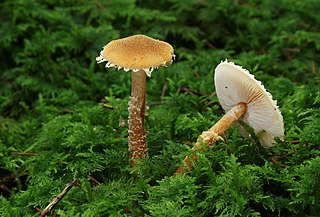
Cystoderma amianthinum, commonly called the saffron parasol, the saffron powder-cap, or the earthy powder-cap, is a small orange-ochre, or yellowish-brown, gilled mushroom. It grows in damp mossy grassland, in coniferous forest clearings, or on wooded heaths. It is probably the most common of the small genus Cystoderma. It is not recommended for consumption due to its resemblance to poisonous species.

Gymnopilus ventricosus, commonly known as the jumbo gym, is a species of mushroom in the family Hymenogastraceae. It was first described from the Stanford University campus by Franklin Sumner Earle as Pholiota ventricosa in 1902.

Pholiota malicola, commonly known as the forgettable pholiota, is an inedible species of fungus in the mushroom family Strophariaceae. Originally called Flammula malicola by mycologist Calvin Henry Kauffman in 1926, it was transferred to the genus Pholiota by Alexander H. Smith in 1934. It is found in North America and Australia.

Pholiota flammans, commonly known as the yellow pholiota, the flaming Pholiota, or the flame scalecap, is a basidiomycete agaric mushroom of the genus Pholiota. Its fruit body is golden-yellow in color throughout, while its cap and stem are covered in sharp scales. As it is a saprobic fungus, the fruit bodies typically appear in clusters on the stumps of dead coniferous trees. P. flammans is distributed throughout Europe, North America, and Asia in boreal and temperate regions. Its edibility has not been clarified.
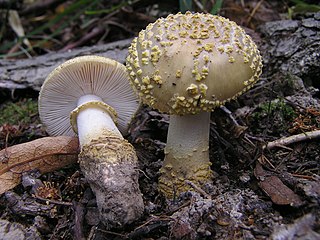
Amanita franchetii, also known as the yellow veiled amanita, or Franchet's amanita, is a species of fungus in the family Amanitaceae.

Pholiota squarrosa, commonly known as the shaggy scalycap, the shaggy Pholiota, or the scaly Pholiota, is a species of mushroom in the family Strophariaceae. Common in North America and Europe, it is a secondary parasite, in that it attacks trees that have already been weakened from prior injury or infection by bacteria or other fungi. It has a wide range of hosts among deciduous trees, although it can also infect conifers. It can also live as a saprobe, deriving nutrients from decomposing wood.
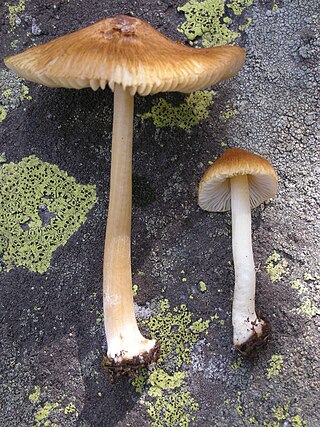
Inocybe praetervisa is a small, yellow and brown mushroom in the family Inocybaceae, distinguished from other members of the genus by its unusual spores and bulb. The unusual spores led to the species being named the type species of the now-abandoned genus Astrosporina; recent studies have shown that such a genus could not exist, as the species with the defining traits do not form a monophyletic group. However, it is a part of several clades within the genus Inocybe. I. praetervisa grows on the ground in woodland, favouring beech trees, and is found in Europe, North America and Asia. It is inedible and probably poisonous due to the presence of muscarine. The ingestion of muscarine can lead to SLUDGE syndrome, and could potentially lead to death due to respiratory failure.
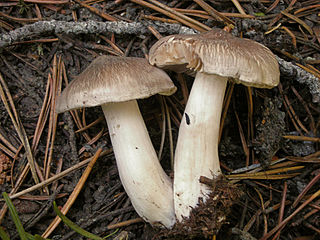
Tricholoma virgatum, commonly known as the ashen knight, is a mushroom of the agaric genus Tricholoma. It was first described scientifically as Agaricus virgatus by Elias Fries in 1818, and later transferred to the genus Tricholoma by Paul Kummer in 1871. It is found in the deciduous and coniferous forests of Europe, North America, and China. The mushroom is inedible, speculated to be poisonous, and has a bitter and peppery taste and musty odor.

Pholiota aurivella, commonly known as the golden pholiota, is a species of fungus in the family Strophariaceae that is found in native forest of New Zealand, southern Canada, and in the United States. It is frequently found in the American West and Southwest, especially in late summer and fall. Most field guides list it as inedible, with one reporting that it contains toxins which cause gastric upset. According to David Arora, the taste resembles "marshmallows without the sugar." It is sticky or slimy when moist and grows in clusters on live or dead trees.

Phellodon tomentosus, commonly known as the zoned phellodon or zoned cork hydnum, is a species of tooth fungus in the family Bankeraceae. First described as Hydnum tomentosum by Carl Linnaeus in 1753, it was transferred to the genus Phellodon by Howard James Banker in 1906. It is found in Asia, Europe, and North America.

Amanita excelsa, also known as the European false blushing amanita, is a species of agaric fungus in the family Amanitaceae. It is found in Asia, Europe, and North America, where it grows in deciduous forests.
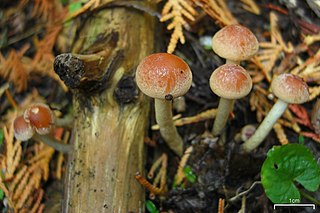
Pyrrhulomyces astragalinus, commonly known as the pinkish-orange pholiota, is a species of fungus in the family Strophariaceae. It was first described scientifically in 1821 by Elias Magnus Fries as a species of Agaricus. Rolf Singer transferred it to the genus Pholiota in 1951 and the species was transferred to its present genus in 2020 by E.J. Tian & Matheny. The fruitbodies of the fungus have pinkish-orange caps measuring 2–5.5 cm in diameter. The flesh is orange, blackening in age, with a bitter taste. They produce a reddish-brown spore print, causing it to be placed in its genus rather than Hypholoma, which it resembles. The spores are oval to elliptical, smooth with thin walls, and measure 5–7 by 4–4.5 μm. In North America, the fungus is found in the United States and Canada. In Europe, it has been recorded from France, Sweden, and Switzerland. Its mushrooms usually grow singly or in small clusters, sometimes on conifer logs.

Melanoleuca cognata, commonly known as the spring cavalier, is an edible species of agaric fungus. It is found in Europe and North America in forests, meadows, and parks. The species may be difficult to identify without analysis of its microscopic features.

Pholiota squarrosoides is a species of mushroom in the family Strophariaceae. It is similar to the species Pholiota squarrosa. There are differing accounts on whether the mushroom is edible.




















